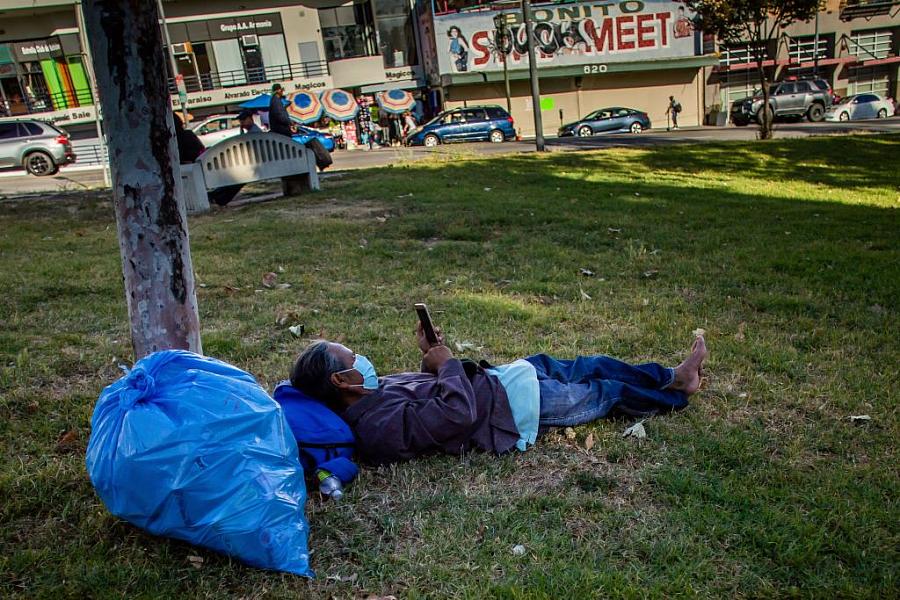Has LA failed homeless residents during the pandemic?

A homeless man lies on the grass in MacArthur Park in Los Angeles in May.
(Photo by Apu Gomes/AFP via Getty Images)
Los Angeles was already facing a public health crisis when the pandemic hit. Over 66,000 people were living on the streets and in vehicles across the county, the majority of them unable to access basic services like restrooms, showers and health care.
For three years a coalition of over 30 homeless advocacy groups petitioned the city to divest from an enforcement based approach to sanitation cleanings — or “sweeps” as they’re called — and invest in services like showers, restrooms, sharps containers and basic trash receptacles. The city invests millions of dollars to conduct sanitation sweeps that push people further into homelessness. According to the Los Angeles Homeless Services Authority (LAHSA): “Fines and citations, encampment clearings and other municipal practices and policies that disrupt and displace people create additional barriers and setbacks for people experiencing homelessness, making it more likely that people will remain homeless even longer.”
The city eventually modified its sanitation program to offer more services to unhoused people during sanitation cleanings, but they failed to eliminate police from sweeps and fell short of the demands that the coalition of organizations were asking for.
Then the pandemic hit.
When Los Angeles went into lockdown in mid-March, the city and county scrambled to create services, housing and reform policies that homeless advocates had been pushing for for years. They promptly converted recreation centers into temporary shelters and rolled out hundreds of hand-washing stations near encampments. Sanitation cleanings and tickets issued for street cleaning were halted. And they began looking into leasing vacant hotel rooms to house the most vulnerable of the houseless community.
While these services might have been well-intentioned and they met some of the demands of organizers and the homeless community, over time it became clear that the city couldn’t meet its goals or properly maintain the services. The city quickly had to drastically reduce the number of shelter beds at recreation centers to create more space between people, after concerns about pushing hundreds of people into small interior spaces and as COVID-19 cases began spiking at other homeless shelters. By late August, the city planned to end the recreation center program, potentially pushing hundreds of unhoused people onto the streets during a heatwave.
Project Roomkey — the initiative to house homeless people over the age of 65 or with preexisting conditions in vacant hotel rooms — was difficult to get enrolled in, even for people that qualified, and today the city is nowhere near its goal of housing 15,000 people.
And the hundreds of handwashing stations that the city rolled out quickly began going dry, which I reported on for Curbed LA in April. I found that some hand-washing stations in MacArthur Park were without water, others were without soap and some didn’t have either.
City and county leaders failed some of the most vulnerable Angelenos at a deadly time.
Last year, three unhoused Angelenos died every day. This year the number has increased to four per day.
My 2020 Data Fellowship project will center on a specific service that the city established in response to the pandemic. I plan on collecting data, mapping it and then overlaying census data and other demographic data to find out who specifically was impacted by these services.
Some of the areas in Los Angeles most impacted by homelessness are also some of the poorest. The median income in Skid Row for example —arguably the largest concentration of unhoused people in the country — is less than $12,000. And over 75% of the residents are BIPOC.
Black and Latinx people account for over 65% of the unhoused population in LA. Black people are four times more represented in the unhoused population than in the county population. In many ways, to fail the homeless community is to fail the black and brown community. My project will examine the correlations between public health, homelessness and socioeconomic status.
I will also interview unhoused residents to hear about their experiences managing their hygiene during the pandemic — when so many vital resources such as libraries and gyms closed — and learn about how they overcame those barriers. Additionally, I anticipate speaking with homeless service providers and organizers to get a full picture on the various approaches to helping the homeless.

